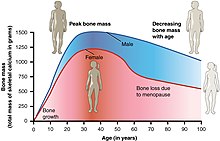Osteopenia
For people with risk factors, screening via a DXA scanner may help to detect the development and progression of low bone density.
Prevention of low bone density may begin early in life and includes a healthy diet and weight-bearing exercise, as well as avoidance of tobacco and alcohol.
An incomplete list of risk factors:[4][5][6]The ISCD (International Society for Clinical Densitometry) and the National Osteoporosis Foundation recommend that older adults (women over 65 and men over 70) and adults with risk factors for low bone mass, or previous fragility fractures, undergo DXA testing.
The National Osteoporosis Foundation recommends use of central (hip and spine) DXA testing for accurate measure of bone density, emphasizing that peripheral or "screening" scanners should not be used to make clinically meaningful diagnoses and that peripheral and central DXA scans cannot be compared to each other.
[22] DXA scanners can be used to diagnose osteopenia or osteoporosis as well as to measure bone density over time as people age or undergo medical treatment or lifestyle changes.
[24][25][26][18] The ISCD recommends that Z-scores, not T-scores, be used to classify bone density in premenopausal women and men under 50.
[27] Actions to maximize bone density and stabilize loss include:[28][29][30][31] The pharmaceutical treatment of osteopenia is controversial and more nuanced than well-supported recommendations for improved nutrition and weight-bearing exercise.
[37][38] In addition to bone density (T-score), calculation of the FRAX score involves age, body characteristics, health behaviors, and other medical history.
[48][34] An osteoporosis epidemiologist at the Mayo Clinic who participated in setting the criterion in 1992 said "It was just meant to indicate the emergence of a problem", and noted that "It didn't have any particular diagnostic or therapeutic significance.


